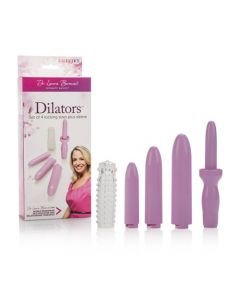Vaginal Dilators
Vaginal dilators are tools that can be used to achieve or restore flexibility of the vaginal tissues. However useful they may be, they can definitely be intimidating and it’s not always obvious how to use them properly and successfully. With this blog I hope to shed some light on vaginal dilators themselves and who can benefit from using them.
There are a number of reasons that an individual could benefit from the use of vaginal dilators, but generally speaking the main reason is achieving or restoring comfortable vaginal penetration. Specific goals of clients can vary; common reasons include being able to have pain free intercourse, to insert a tampon, or to have pain free vaginal exams when visiting the doctor. Additionally, after male to female transition surgery vaginal dilators are used to ensure the vaginal canal remains flexible and restrictive scar tissue does not form. Specific conditions that can benefit from dilator use include: vaginismus, dyspareunia, pelvic floor hypertonicity, menopausal vaginal atrophy, vulvodynia, and other types of pelvic pain.
There are lots of different options for vaginal dilators available on the market, so it can be a little overwhelming to browse through and make a choice about what’s best for you. What they all have in common is the cylindrical shape, and often times there is a tapered end on one side, and some sort of handle or base on the other. Most of the vaginal dilators available are made from silicone or plastic – silicone being softer to touch and plastic harder. Often times vaginal dilators are available for purchase as a set, so you get a variety of sizes (usually 4-5 different ones). They are designed so that each size up is slightly larger than the last in terms of circumference and length. This is very useful because an individual can start with using a size they are comfortable with, and gradually progress through the set until they are comfortable with the size that is consistent with their goal.
Vaginal dilators work by progressively stretching and desensitizing the vaginal tissues. It is very important to note that it is quite common to have anxieties or fears around vaginal penetration in individuals with pelvic pain. This can lead to increased muscle tension and pain with attempted insertion, as the body is trying to protect itself from what it perceives as dangerous. In order to be successful with dilator use, the best approach is to maintain comfort throughout the process, starting with techniques like visualization if necessary and slowly progressing in a way that is not eliciting pain. This strategy allows for gradual reframing of vaginal insertion as a non-painful experience. Therefore, the dilators are not just simply stretching the muscles, but also helping to alleviate negative perceptions and associations around vaginal penetration. When used properly, dilators treat both the body and mind!
To summarize, vaginal dilators can be very helpful tools to achieve or restore the ability to have pain free vaginal insertion in individuals who experience pelvic pain or difficulty with penetration. A pelvic floor physiotherapist can help you identify what type of dilators would best suit you, and assist you in using them in a way that allows you to reach your goals.
Click on the images below to learn more about two common types of dilators that we often use in our physiotherapy practice for clients struggling with pelvic pain or pain with penetration.



